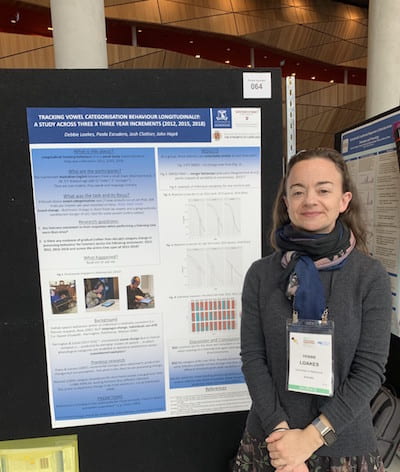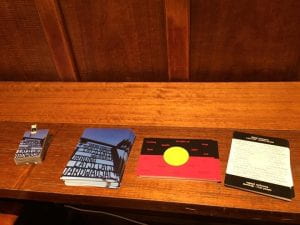
Debbie Loakes: My forensic origin story
How I became interested in Forensic Linguistics and Forensic Phonetics
I studied my undergraduate degree in Linguistics at Monash University. I remember looking at the handbook (which was a huge printed document in those days!) and wanting to know more about forensic linguistics – curiosity about this subject is what got me into studying linguistics from the very beginning. I had the opportunity to learn a lot more about this field during my Honours year, working with Dr. Laura Tollfree as my supervisor. She also brought me along to a court case in which she was giving evidence, sometime toward the end of my Honours year, further piquing my interest in the field. During a couple of our supervision sessions Laura would tell me about her friend and colleague Helen Fraser, who I later met at conferences, so I have known about, and followed, Helen’s work for over 20 years.
*I was inspired to use the term “origin story” after
listening to Lingthusiasm’s bonus episode no. 42!
After my Honours year, I moved to The Phonetics Laboratory at The University of Melbourne for my PhD study. Under the supervision and guidance of Professor Janet Fletcher, I carried out my research in the field of forensic phonetics, looking at features of twins’ speech. I was inspired by a study I had read about by Francis Nolan (who was head of the phonetics lab at Cambridge, and student Thomasina Oh. Their study is available here.
A copy of the extended abstract listing the main findings of my PhD work is available here. I have also recently written a chapter on twin’s speech for the Oxford Handbook of Forensic Phonetics; which was a chance to review new work done in this area over the past 15 years (some of which I have been involved in). This chapter is currently under review.
Broadening my interests…
After I graduated from my PhD, I was still interested in studying forensics, and individual differences in speech, but one of the main findings of my thesis is that the available reference samples used for forensic speaker comparison were not reflective of changes that had occurred in speech over time. This finding is often cited by other researchers, e.g. recently in the journal Science and Justice (Gold and Hughes 2014: 295) and Linguistics Vanguard (Hughes & Wormald 2020: 4). I began to become very interested in sound change and also started looking at particular speech patterns in certain regional areas in particular, see this Crikey blog post and this journal article. Not too long after I graduated, I was also fortunate to be a Chief Investigator of AusTalk, which is indeed a large corpus of spoken language that can be accessed by researchers, for forensic phonetic research and various other topics.
Over the years, I have been lucky enough to work in roles where I have continued to document accent and speech variation in Australia, and while doing this I also became especially interested in how people process language. This year I am finishing up my role on a project called “A sociophonetic study of Aboriginal English” in the ARC Centre of Excellence for the Dynamics of Language. I learnt a lot during this project and thoroughly enjoyed my time in CoEDL, especially pre-pandemic where it was possible to travel between institutions and field sites more freely. I also had the opportunity to work with Indigenous people on some outreach projects, which was a great experience made possible through CoEDL – see for example the Strengthening Languages project in Mildura. The collaborative nature of CoEDL means research relationships I made during this time are still strong, despite the lack of travel.
Getting back into forensics
In planning what to do after my time in CoEDL, I expressed an interest in “getting back into forensics”. In fact, for my return to this scene I presented a paper at the 2019 International Association of Forensic Linguists annual conference, which was in Melbourne. I was happy to see some familiar faces and meet new people whose work I had read. Not long after this (in fact around one month), the International Congress of Phonetic Sciences was also held in Melbourne. During that week, Helen Fraser was visiting Melbourne to present her work and we had an opportunity to discuss plans for bringing “forensics” to the School of Languages and Linguistics at The University of Melbourne. I expressed a strong interest in joining this venture, as it aligned well with the plan I had made for myself and with knowledge I had gained from my previous research. At the end of 2019, I applied for Head of School Investment funding to run a workshop at The University of Melbourne called From linguistic analysis to forensic conclusions: Melbourne linguistics and law interdisciplinary workshop which took place on Dec. 17 that year. This was a very enjoyable event with linguists, law researchers and lawyers from around Australia present, discussing recent work and issues in the field.
The Research Hub for Language in Forensic Evidence
The Research Hub for Language in Forensic Evidence, comprising Helen as director and me as a Research Fellow, had a very slow beginning in 2020. Its planned start effectively coincided with the start of the pandemic in Australia and the closure of the University of Melbourne shutdown, so the official beginning was delayed. Helen and I nevertheless began working together remotely, and wrote our first joint authored publication together (Fraser and Loakes, 2020) called Acoustic injustice: The experience of listening to indistinct covert recordings presented as evidence in court. It is a “myth busting” article about the experience of listening to indistinct audio with legally sanctioned forms of assistance, and the actual effects of this assistance on perception of the content of the recording, as understood via psycholinguistic experiments. In 2020 I also remotely supervised two excellent students who studied forensic linguistic topics – Honours student Conor Clements who worked on a project called Forensic Audio in Context: A Study in Perceptual Phonetics and Masters student Chris Spathis whose project was titled Folk Linguistics and Forensic Linguists: Authorship Analysis in the media.
The Hub had its official launch in October 2020, and Helen and I started working in earnest in this venture in early 2021. We will be posting news (like this) and research updates regularly.
References:
Fraser, Helen and Debbie Loakes (2020) called “Acoustic injustice: The experience of listening to indistinct covert recordings presented as evidence in court”. Mehera San Roque, Sarah Ramshaw and James Parker (Eds.) Law, Text, Culture (special issue “The Acoustics of Justice: Law, Listening, Sound”).
Gold, Erica and Vincent Hughes (2014) “Issues and opportunities: The application of the numerical likelihood ratio framework to forensic speaker comparison” Science and Justice Vol. 54 (4), 294-299.
https://doi.org/10.1016/j.scijus.2014.04.003
Hughes, Vincent and Jessica Wormald (2020) “Sharing innovative methods, data and knowledge across sociophonetics and forensic speech science” Linguistics Vanguard, Vol. 6 (1), 1-9.
https://doi.org/10.1515/lingvan-2018-0062
Loakes, Debbie (2008) “A Forensic Phonetic Investigation into the Speech Patterns of Identical and Non-Identical Twins’ (PhD Abstract)” The International Journal of Speech, Language and the Law: Forensic Linguistics, Vol. 15 (1) pp.97-100.
https://doi.org/10.1558/ijsll.v15i1.97
Loakes, D., J. Hajek and J. Fletcher (2017) “Can you t[æ]ll I’m from M[æ]lbourne? An overview of the DRESS and TRAP vowels before /l/ as a regional accent marker in Australian English” English World-wide, Vol. 38 (1), pp.29-49.
https://doi.org/10.1075/eww.38.1.03loa
Nolan, F., & Oh, T. (2013). Identical twins, different voices. International Journal of Speech Language and the Law, Vol.3 (1), 39–49.

